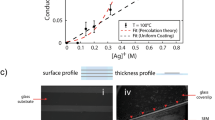Abstract
We describe investigations toward a disposable polymer-based chip for the isolation of eukaryotic mRNA. This work focuses here on the improvement of the fabrication methods for rapid prototyping and the actual application at lowest RNA concentrations with total channel volumes of 3.5 μL. Messenger RNA isolation was achieved using paramagnetic oligo (dT)25 beads within a microfluidic channel which incorporated a sawtooth microstructured design to aid in mixing. The structures were shown to facilitate mixing beteen two fluids in parallel flow when compared to a channel without structures. The chip was fabricated by means of hot embossing poly(methyl methacrylate) (PMMA) using a copper master. Copper was used as the master material due to its excellent thermal, mechanical, and electroplating properties. Fabrication of the master consisted of the structuring of a polished copper plate using KMPR 1050 as an electroplating mold for forming the microchannel structures. The copper master was found to be much more robust than traditional silicon masters used for prototyping. The use of KMPR enabled the generation of high straight walls in contrast to SU-8 masters. In addition, embossing times were able to be decreased by a factor of 3 due to improved heat conduction and avoidance of a lengthy and delicate de-embossing step.






Similar content being viewed by others
References
Becker H, Heim U (2000) Hot embossing as a method for the fabrication of polymer high aspect ratio structures. Sens Actuators A Phys 83:130–135. doi:10.1016/S0924-4247(00)00296-X
Byeon KJ, Yang KY, Lee H (2007) Thermal imprint lithography using sub-micron sized nickel template coated with thin SiO2 layer. Microelectron Eng 84:1003–1006. doi:10.1016/j.mee.2007.01.102
Callister WD (1999) Materials science and engineering: an introduction. Wiley, New York
Cameron NS, Roberge H, Veres T, Jakeway SC, Crabtree HJ (2006) High fidelity, high yield production of microfluidic devices by hot embossing lithography: rheology and stiction. Lab Chip 6:936–941. doi:10.1039/b600584e
Chen ZF, Gao YH, Lin JM, Su RG, Xie Y (2004) Vacuum-assisted thermal bonding of plastic capillary electrophoresis microchip imprinted with stainless steel template. J Chromatogr A 1038:239–245. doi:10.1016/j.chroma.2004.03.037
Connelly JT, Nugen SR, Borejsza-Wysocki W, Durst RA, Montagna RA, Baeumner AJ (2008) Human pathogenic Cryptosporidium species bioanalytical detection method with single oocyst detection capability. Anal Bioanal Chem 391:487–495. doi:10.1007/s00216-008-1967-2
Esch MB, Kapur S, Irizarry G, Genova V (2003) Influence of master fabrication techniques on the characteristics of embossed microfluidic channels. Lab Chip 3:121–127. doi:10.1039/b300730h
Goral VN, Zaytseva NV, Baeumner AJ (2006) Electrochemical microfluidic biosensor for the detection of nucleic acid sequences. Lab Chip 6:414–421. doi:10.1039/b513239h
Jiang GF, Harrison DJ (2000) mRNA isolation in a microfluidic device for eventual integration of cDNA library construction. Analyst (Lond) 125:2176–2179. doi:10.1039/b005999o
Kelly RT, Woolley AT (2003) Thermal bonding of polymeric capillary electrophoresis microdevices in water. Anal Chem 75:1941–1945. doi:10.1021/ac0262964
Klank H, Kutter JP, Geschke O (2002) CO2-laser micromachining and back-end processing for rapid production of PMMA-based microfluidic systems. Lab Chip 2:242–246. doi:10.1039/b206409j
Liqun D, Chong L, Yi L, Zhifeng C, Denan C, Min W, Rong C (2004) Fabrication of microfluidic chip and its application, The Fourth Symposium Micro-Nanomechatronics for Information-Based Society, pp 237–242
Lund-Olesen T, Dufvaa M, Hansen MF (2007) Capture of DNA in microfluidic channel using magnetic beads: increasing capture efficiency with integrated microfluidic mixer. J Magn Magn Mater 311:396–400. doi:10.1016/j.jmmm.2006.10.1171
Nichols KP, Ferullo JR, Baeumner AJ (2006) Recirculating, passive micromixer with a novel sawtooth structure. Lab Chip 6:242–246. doi:10.1039/b509034b
Peng Z, Gang L, Yangchao T, Xuehong T (2005) The properties of demoulding of Ni and Ni-PTFE moulding inserts. Sens Actuators A Phys 118:338–341. doi:10.1016/j.sna.2004.08.028
Sander D, Hoffmann R, Relling V, Muller J (1995) Fabrication of metallic microstructures by electroplating using deep-etched silicon molds. J Microelectromech Syst 4:81–86. doi:10.1109/84.388116
Wang J, Pumera M, Chatrathi MP, Escarpa A, Konrad R, Griebel A, et al. (2002) Towards disposable lab-on-a-chip: poly(methylmethacrylate) microchip electrophoresis device with electrochemical detection. Electrophoresis 23:596–601. doi :10.1002/1522-2683(200202)23:4<596::AID-ELPS596>3.0.CO;2-C
Xu G, Wang J, Chen Y, Zhang L, Wang D, Chen G (2006) Fabrication of poly(methyl methacrylate) capillary electrophoresis microchips by in situ surface polymerization. Lab Chip 6:145–148. doi:10.1039/b515842g
Zhao YJ, Cui TH (2003) Fabrication of high-aspect-ratio polymer-based electrostatic comb drives using the hot embossing technique. J Micromech Microeng 13:430–435. doi:10.1088/0960-1317/13/3/312
Acknowledgments
This work was performed in part at the Cornell NanoScale Facility, a member of the National Nanotechnology Infrastructure Network, which is supported by the National Science Foundation (Grant ECS 03-35765). This work was partially funded under a grant from the New York State Office of Science, Technology and Academic Research (NSYTAR) and a Merck Corporation undergraduate student summer fellowship program in biological engineering. This work also made use of STC shared experimental facilities supported by the National Science Foundation under Agreement No. ECS-9876771.
Author information
Authors and Affiliations
Corresponding author
Rights and permissions
About this article
Cite this article
Nugen, S.R., Asiello, P.J. & Baeumner, A.J. Design and fabrication of a microfluidic device for near-single cell mRNA isolation using a copper hot embossing master. Microsyst Technol 15, 477–483 (2009). https://doi.org/10.1007/s00542-008-0694-0
Received:
Accepted:
Published:
Issue Date:
DOI: https://doi.org/10.1007/s00542-008-0694-0




